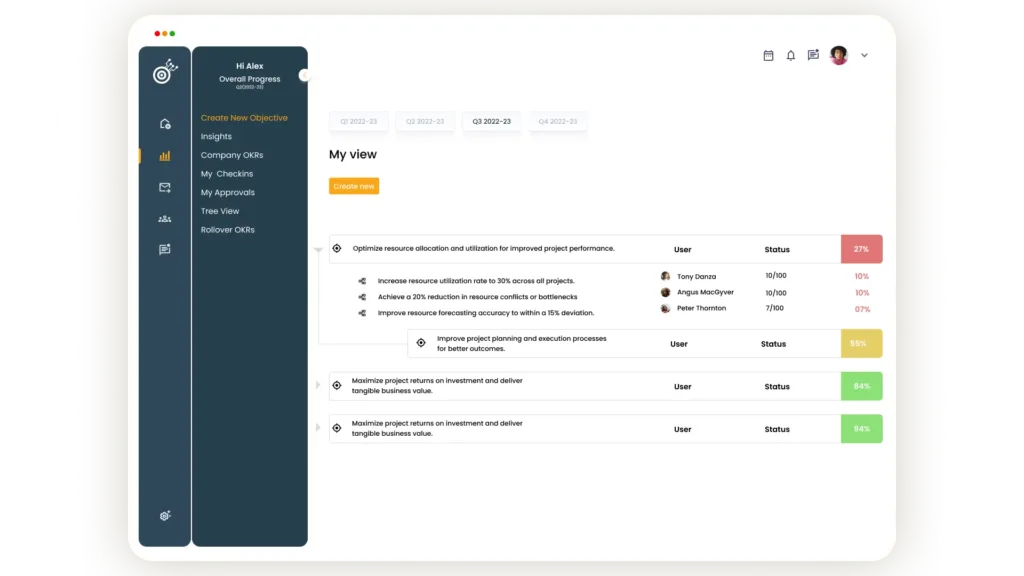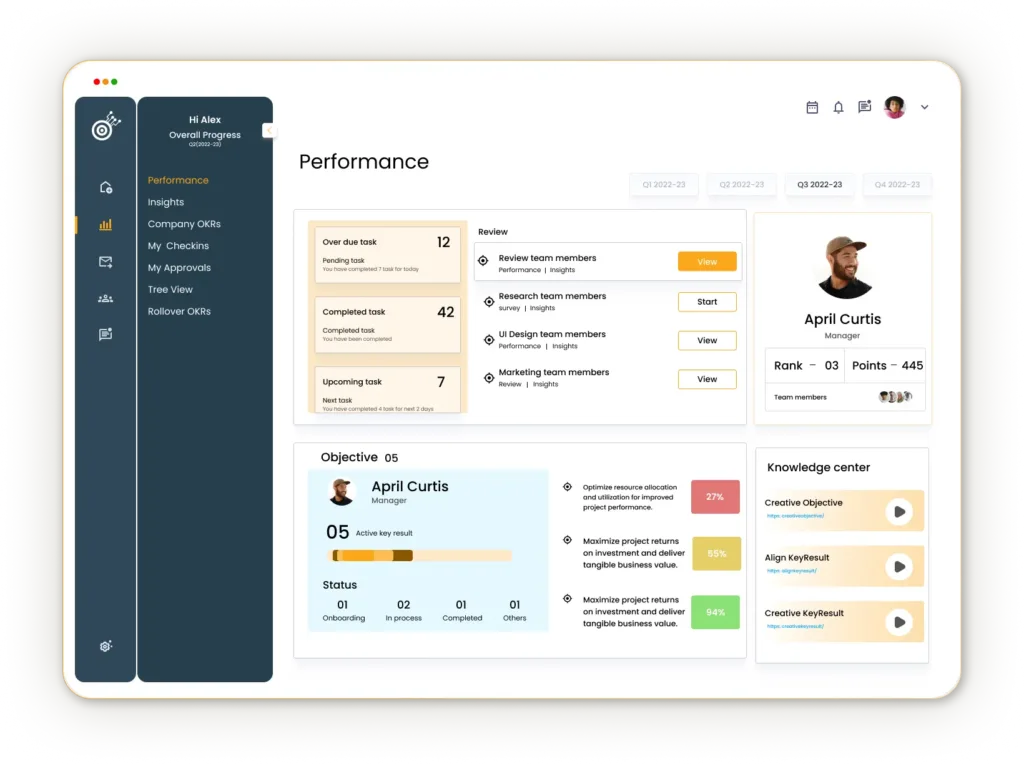Today’s businesses are very dynamic in nature and the value of organizations lies within their labor. Innovation, productivity, and overall success are driven by engaged employees. However, it is a hard task to engage the employees. This is where effective performance management solutions come in. An environment that fosters employee engagement, motivation, and growth can be nurtured by using strategic performance management techniques.
Table of Contents
Demystifying Performance Management
At its core, performance management is a continuous process that aligns individual and organizational objectives. It involves setting clear expectations, providing constructive feedback, recognizing achievements, and supporting professional development. This holistic approach not only enhances employee performance but also fosters a sense of purpose and belonging within the organization.
The Symbiotic Relationship: Performance Management and Employee Engagement
Performance management and employee engagement are intrinsically linked, forming a symbiotic relationship. When employees feel valued, and supported, and have a clear understanding of their roles and goals, they are more likely to be engaged and invested in their work. Conversely, engaged employees are more motivated to contribute their best efforts, leading to improved organizational performance.
The Multifaceted Benefits of Effective Performance Management
Implementing effective performance management solutions can yield a myriad of benefits for both employees and organizations:
- Aligning Goals and Objectives: By setting clear and measurable goals that align with the company’s overall vision, employees gain a sense of direction and purpose, leading to increased commitment and motivation.
- Fostering Open Communication: Regular check-ins and feedback sessions promote transparency and open communication, building trust and minimizing misunderstandings within teams.
- Identifying Strengths and Areas for Improvement: Effective performance management helps identify individual strengths and areas where improvement is needed, enabling tailored training programs and professional development opportunities.
- Promoting Fairness and Meritocracy: By recognizing and rewarding excellent performers, while providing coaching and support to those who need it, an efficient performance management system ensures fairness in career advancement opportunities, promoting growth and retention of top talent.
- Enhancing Productivity and Business Success: Ultimately, engaged and motivated employees contribute to increased productivity, leading to greater organizational effectiveness and overall business success.
The Pillars of Engagement-Driven Performance Management
To effectively drive employee engagement through performance management solutions, organizations should focus on the following key pillars:
1. Clarity and Goal Alignment
Organizations need to assign clarity to their employees by providing well-defined objectives and expectations so that they can become actively involved in the affairs of the company. When employees know how their work contributes to overall results, they tend to be more committed towards attaining personal success as well as organizational goals. This creates a sense of purpose and direction in aligning individual goals with those of the organization hence fostering a team-based and focused work environment.
2. Continuous Feedback and Recognition
Continuous feedback is what makes performance management effective because it enables employees to see their strengths, and weaknesses as well as understand the impact of their contributions made so far. On the other hand, constructive feedback has no meaning without purposeful acknowledgment; therefore it should always be followed by rewards that recognize even the smallest achievements. Morally speaking, this announcement helps build up firmness of position while keeping desired behaviors alive and establishing an atmosphere where people’s efforts are highly appreciated.
3. Professional Growth Opportunities
Trust is built and transparency is nurtured in an efficient performance management system. Employees’ involvement in the setting of goals, being part of their own career growth process, and utilizing objective metrics during appraisals can make organizations trusted and fair in nature. Trust creates a sense of collaboration, creativity, and organization.
4. Trust and Transparency
Building trust and fostering transparency are essential components of an effective performance management system. Organizations can create an environment of trust and fairness by involving employees in goal-setting processes, allowing them to play an active role in their career growth, and using objective metrics for performance evaluations. This trust fosters collaboration, creativity, and a sense of belonging within the organization.
5. Leveraging Technology
Technology has become so important especially when it comes to making work easier through improving performance systems at the workplace in the twenty-first century. The use of employee engagement software and performance management platforms may assist businesses automate tasks, tracking progress and obtaining insights through analytics-driven data. This increases efficiency while managers can easily communicate with employees on these tools.
Tailoring Performance Management Solutions
While the principles of effective performance management are universal, it is crucial to tailor solutions to align with an organization’s unique culture, industry, and challenges. By understanding the specific needs and dynamics of the workforce, organizations can customize their approach, ensuring that performance management initiatives resonate with employees and drive meaningful engagement.
The Performance Management Toolkit
Successful performance management solutions often incorporate a combination of techniques and strategies. Here are some commonly used tools in the performance management toolkit:
Goal Setting: Establishing specific, measurable, achievable, relevant, and time-bound (SMART) goals for employees, aligned with organizational objectives.

Performance Reviews: Conduct regular performance evaluations to assess progress, identify areas for improvement, and provide constructive feedback.

360-Degree Feedback: Gathering input from multiple sources, including peers, managers, subordinates, and clients, to gain a comprehensive understanding of an employee’s strengths and weaknesses.

Coaching and Mentoring: Providing guidance, support, and advice to employees through formal or informal coaching and mentoring programs.
Training and Development: Offering opportunities for skill enhancement, knowledge acquisition, and professional growth through training programs, workshops, and educational resources.
Rewards and Recognition: Implementing a system to acknowledge and celebrate employee achievements, contributions, and milestones through monetary or non-monetary rewards.
Career Pathing: Developing clear career paths and succession plans to support employees’ long-term growth and advancement within the organization.
By leveraging a combination of these tools and strategies, organizations can create a comprehensive and tailored performance management solution that drives employee engagement and organizational success.
Overcoming Challenges in Performance Management Implementation
While the benefits of effective performance management solutions are numerous, their implementation can present challenges. Common obstacles include resistance to change, lack of buy-in from managers and employees, and the complexity of aligning processes across different departments or locations.
To overcome these challenges, organizations should prioritize clear communication, provide comprehensive training and support, and actively involve employees and managers in the implementation process. By addressing concerns, fostering a culture of continuous improvement, and celebrating successes along the way, organizations can navigate the challenges and ensure a smooth transition to an effective performance management system.
The Role of Leadership in Driving Engagement through Performance Management
Effective performance management solutions require strong leadership commitment and support. Leaders play a crucial role in setting the tone, fostering a culture of continuous improvement, and leading by example. By actively participating in performance management processes, providing guidance and support to managers, and championing the importance of employee engagement, leaders can inspire and motivate their teams to embrace and contribute to the success of performance management initiatives.
Measuring Success: Evaluating the Impact of Performance Management Solutions
To ensure the effectiveness of performance management solutions and their impact on employee engagement, organizations should establish clear metrics and regularly evaluate their performance. Key performance indicators (KPIs) such as employee satisfaction scores, retention rates, productivity metrics, and customer satisfaction levels can provide valuable insights into the success of performance management initiatives.
By continuously monitoring and analyzing these metrics, organizations can identify areas for improvement, make data-driven decisions, and refine their performance management strategies to better align with the evolving needs of their workforce and business objectives.
The Path to Sustained Organizational Success
Implementing effective performance management solutions is not a one-time endeavor but rather an ongoing journey of continuous improvement. As organizations evolve and adapt to changing market conditions, their performance management strategies must also evolve to remain relevant and impactful.
By fostering a culture of learning, embracing feedback, and staying attuned to the needs and preferences of their workforce, organizations can ensure that their performance management solutions remain effective drivers of employee engagement, contributing to sustained organizational success and a competitive advantage in the marketplace.
Conclusion
At Datalligence, we understand the transformative power of effective performance management solutions in driving employee engagement and organizational success. Our comprehensive suite of performance management tools and employee engagement solutions are designed to empower organizations to unlock the full potential of their workforce.
With our cutting-edge technology, expert guidance, and data-driven insights, we help organizations streamline their performance management processes, foster a culture of continuous improvement, and cultivate an engaged and motivated workforce. By partnering with Datalligence, companies can embark on a journey toward sustained organizational success, where engaged employees are the driving force behind innovation, productivity, and long-term growth.











